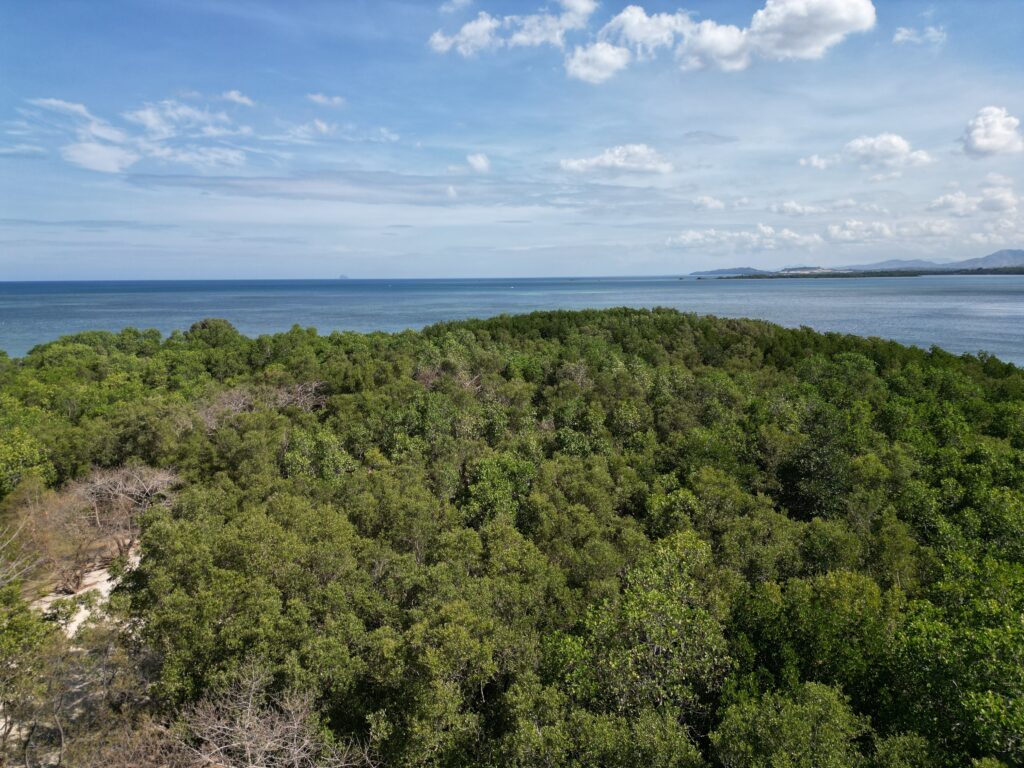
Healing our climate through mangrove-related Nature-based Solutions

Mangroves are among the most powerful natural carbon sinks on Earth. Considered blue carbon coastal ecosystems, mangroves can regulate greenhouse gas emissions and reduce CO2 levels in the atmosphere.
Philippine mangroves sequester approximately 1,083 metric tons of carbon per hectare—nearly five times more than terrestrial forests. Mangroves have been estimated to sequester $3,200-$6,400-worth of carbon per hectare per year, using 2021 carbon prices (Zeng et al., 2021).
Moreover, mangroves are the natural defense of coastal communities against storm surges and flooding. They reduce wave energy by 66% and prevent soil from eroding along coastlines. Given their unique ability to regulate water flow, mangroves spare around 613,500 Filipinos from floods and avert ₱55 billion worth of damages.
But despite the immense value of mangroves, these coastal ecosystems continue to deteriorate and diminish at an alarming rate. Human activity and development threaten these ecosystems like no other.
A false dichotomy between development and environmental protection continues to pervade modern Filipino consciousness. Thus, mangroves continue to be cut (albeit illegally) to give way to infrastructure projects and aquaculture production.
There have been attempts to implement mitigation measures such as mangrove earthballing and tree replacement. However, studies have proven the failure of such measures. A study done by Wodehouse and Rayment (2019) found that earthballing disrupts mangrove ecosystems, breaking the integrated connection of soil, water, and vegetation that mangroves have built over the years.
Another study by Abbot and Mahorasy (2014), showed that only young plants not more than 5cm in stem width will survive earthballing. Mangroves in coastal areas targeted for development already have more mature stems 5cm up to 30cm in width and will therefore perish if earballed.
Meanwhile, tree replacement disrupts the already established soil microbiome, carbon stores, hydrological systems, and habitat connectivities hat took decades to develop.
Indeed, the Philippines needs a paradigm shift in its quest for growth and development. Innovation is key to solving the catch-22 situation that policymakers and decision-makers face at a time when economic expansion measures contradict the country’s commitments to the Paris Agreement, Kunming-Montreal Global Biodiversity Framework, Ramsar Convention on Wetlands, and Mangrove Breakthrough Initiative.
Rather than destroying nature to make way for infrastructure and aquaculture, the country should embrace the concept of Building with Nature. Locally proven Green-Gray infrastructure – such as the case of the round-mound breakwaters of the Zoological Society of London – Philippines in Ajuy, Iloilo – have met the need to balance mangrove preservation and infrastructure.
Wetlands International Philippines has also begun to pilot the Associated Mangrove Aquaculture (AMA) in Bataan Province in Manila Bay and in Macajalar Bay. Inspired by the success of AMA in Demak, Indonesia, the approach can balance aquaculture production with mangrove conservation.
There are a number of examples wherein Nature-based Solutions have found the sweet spot in which development and mangrove conservation run in parallel. The human mind is entirely capable of innovation, especially when mindful of the value of mangroves and other coastal ecosystems.
Now that climate change shakes the very fabric of human well-being and survival, it behooves the Philippine government to reject false tradeoffs between gray infrastructure and green ecosystems; and rather, to fund and pioneer truly sustainable development approaches such as Nature-based Solutions and Green-Gray infrastructures.
References:
- Abbot, J. and J. Marohasy. 2014. The excavation and cultivation in containers of mature grey mangroves, Avicennia marina. Wetlands Ecol. Manage. 22: 641-646.
- Menéndez, P., et al. (2020). “The Global Flood Protection Benefits of Mangroves.” Scientific Reports, 10, 4404.
- Pelayo Menéndez, Iñigo J. Losada, Michael W. Beck, Saul Torres-Ortega, Antonio Espejo, Siddharth Narayan, Pedro Díaz-Simal, Glenn-Marie Lange. 2018. Valuing the protection services of mangroves at national scale: The Philippines, Ecosystem Services, Volume 34, Part A, Pages 24-36.
- Wodehouse, D.C.J., & Rayment, M.B. (2019). “Mangrove restoration: Do we know enough?” Restoration Ecology, 27(3), 538-545.
- Zeng, Y., Friess, D.A., Sarira, T.V., Siman, K., & Koh, L.P. (2021). Global potential and limits of mangrove blue carbon for climate change mitigation. Science of the Total Environment, 769, 144752.
